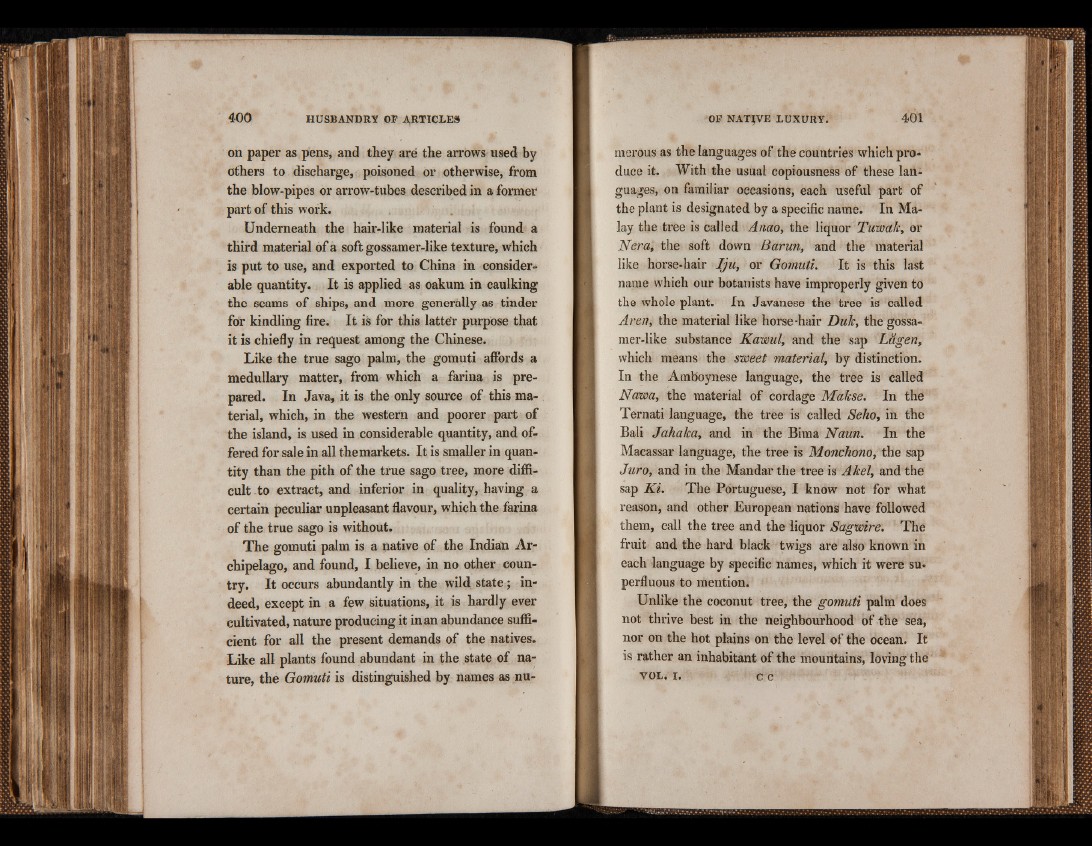
on paper as pens, and they aré the arrows used by
others to discharge, poisoned or otherwise, from
the blow-pipes or arrow-tubes described in a former
part of this work.
Underneath the hair-like material is found á
third material of a soft gossamer-like texture, which
is put to use, and exported to China in considerable
quantity. It is applied as oakum in caulking
the seams of ships, and more generally as tinder
for kindling fire. It is for this latter purpose that
it is chiefly in request among the Chinese.
Like the true sago palm, the gomuti affords a
medullary matter, from which a farina is prepared.
In Java, it is the only source of this material,
which, in the western and poorer part of
the island, is used in considerable quantity, and offered
for sale in all the markets. It is smaller in quantity
than the pith of the true sago tree, more difficult
to extract, and inferior in quality, having a
certain peculiar unpleasant flavour, which the farina
of the true sago is without.
The gomuti palm is a native of the Indian Archipelago,
and found, I believe, in no other country.
It occurs abundantly in the wild, state; indeed,
except in a few situations, it is hardly ever
cultivated, nature producing it in an abundance sufficient
for all the present demands of the natives.
Like all plants found abundant in the state of nature,
the Gomuti is distinguished by names as numerous
as the languages of the countries which produce
it. With the usual copiousness of these languages,
on familiar occasions, each useful part of
the plant is designated by a specific name. In Malay
the tree is called Anao, the liquor Tuwalc, or
Nera, the soft down Bar un, and the material
like horse-hair Iju, or Gomuti. It is this last
name which our botanists have improperly given to
the whole plant. In Javanese the tree is called
Aren, the material like horse-hair DuJc, the gossamer
like substance Kawul, and the sap Lägen,
which means the sweet material, by distinction.
In the Amboynese language, the tree is called
Nawa, the material of cordage Makse. In the
Ternati language, the tree is called Seho, in the
Bali Jahalca, and in the Bima Naun. In the
Macassar language, the tree is Monchono, the sap
Juro, and in the Mandar the tree is Akel, and the
sap Ki. The Portuguese, I know not for what
reason, and other European nations have followed
them, call the tree and the liquor Sagwire. The
fruit and the hard black twigs are also known in
each language by specific names, which it were superfluous
to mention.
Unlike the coconut tree, the gomuti palm does
not thrive best in the neighbourhood of the sea,
nor on the hot plains on the level of the ocean. It
is rather an inhabitant of the mountains, loving the
v o l . i . c c